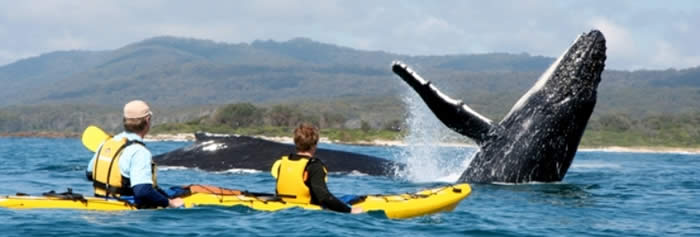Humpback whale facts - megatera novaeangliae

The East Coast Australia population:
1960’s: after excessive hunting along their migration route for years - just 200-400 individuals.
2009 estimate: increase to over 10000 individuals, with an increase of 10-15% per year. Worldwide now over 50,000 individuals.
Humpback distinguishing features:
Dorsal fin two-thirds along their back. Unique tail flukes with scalloped edges.
Unique pectoral (front) flippers up to 6m long, also with bumpy scalloped edges.
Wide blow up to 4m high when exhaling from their twin blowholes.
Southern Hemisphere Humpback whales may have a lot of grey or white on their bodies. “Migaloo” is a famous albino humpback you may be very lucky
to see.
Humpback visible body parts:
Rostrum: Flat area above the mouth, extends back to blowholes. Has bumps (tubercules) on the top.
Pectoral Fins: forward fins, in proportion to a third of the length of the whale’s body.
Dorsal fin: A relatively small fin right on the back about two-thirds along the body. Many different sizes and shapes.
Caudal Peduncle: Sometimes called the tailstock. This is the immensely strong rear section of the body between the dorsal fin and the tail flukes.
Tail Flukes: The two sides of the tail are called flukes. Quite often they carry scars and have bits missing from attacks when the whale was young. Distinctive
and used by scientists to identify individual whales.
What about the hump? They actually don’t have one. They get their name from the arch of their tailstock as they sound – the only whales to have such a
pronounced u-bend.
Humpback behaviours:
Cruising: 2-5 breaths at the surface then dive for up to 10-15 mins but usually less.
Sounding: The whale arches the tailstock into a u-bend as they dive. The distinctive humpback tail flukes are often held high for a moment. Usually indicates
a deeper dive.
Lunging: Front of head (rostrum) comes out of water and dives back under. Sometimes whole head may appear.
Peduncle Slap: Tail is raised and chopped back into the water with a sideways motion using the flexible Peduncle which is the strong muscular area just
before the flukes.
Tail Slapping: Whale is upside down under water. Can smack the whole tail repeatedly on the water in either direction.
Tail Swish or Roll: A flicking movement where the tail is slammed sideways and down as the whale submerges.
Flipper Flapping or Pectoral Slapping: One or both pectoral fins are repeatedly raised and then flopped loudly back onto the surface. Sometimes extended
above water for several minutes. Sometimes appears to be backstroking.
Spy-hopping: The whale hangs vertically sculling in the water and the nose and head may rise upwards, sometimes as far as the eye.
Feeding: You may see one half of a tail fluke and sometimes the belly scything through the water, with rapid changes of direction, followed by a period
underwater then a repeat of the process.
|
Quick Links
|

